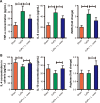Probiotics protect mice from CoCrMo particles-induced osteolysis
- PMID: 28794630
- PMCID: PMC5538695
- DOI: 10.2147/IJN.S130485
Probiotics protect mice from CoCrMo particles-induced osteolysis
Abstract
Wear particle-induced inflammatory osteolysis is the primary cause of aseptic loosening, which is the most common reason for total hip arthroplasty (THA) failure in the med- and long term. Recent studies have suggested an important role of gut microbiota (GM) in modulating the host metabolism and immune system, leading to alterations in bone mass. Probiotic bacteria administered in adequate amounts can alter the composition of GM and confer health benefits to the host. Given the inflammatory osteolysis that occurs in wear debris-induced prosthesis loosening, we examined whether the probiotic Lactobacillus casei could reduce osteolysis in a mouse calvarial resorption model. In this study, L. casei markedly protected mice from CoCrMo particles (CoPs)-induced osteolysis. Osteoclast gene markers and the number of osteoclasts were significantly decreased in L. casei-treated mice. Probiotic treatment decreased the M1-like macrophage phenotype indicated by downregulation of tumor necrosis factor α (TNF-α), interleukin (IL)-6 and inducible nitric oxide synthase (iNOS) and increased the M2-like macrophage phenotype indicated by upregulation of IL-4, IL-10 and arginase. Collectively, these results indicated that the L. casei treatment modulated the immune status and suppressed wear particle-induced osteolysis in vivo. Thus, probiotic treatment may represent a potential preventive and therapeutic approach to reduced wear debris-induced osteolysis.
Keywords: aseptic loosening; gut microbiota; inflammatory cytokines; macrophage polarization; nanotoxicity; wear particles.
Conflict of interest statement
Disclosure The authors report no conflicts of interest in this work.
Figures





Similar articles
-
Anthocyanin suppresses CoCrMo particle-induced osteolysis by inhibiting IKKα/β mediated NF-κB signaling in a mouse calvarial model.Mol Immunol. 2017 May;85:27-34. doi: 10.1016/j.molimm.2017.02.003. Epub 2017 Feb 14. Mol Immunol. 2017. PMID: 28208071
-
Local effect of IL-4 delivery on polyethylene particle induced osteolysis in the murine calvarium.J Biomed Mater Res A. 2013 Jul;101(7):1926-34. doi: 10.1002/jbm.a.34486. Epub 2012 Dec 5. J Biomed Mater Res A. 2013. PMID: 23225668 Free PMC article.
-
Spinal implant debris-induced osteolysis.Spine (Phila Pa 1976). 2003 Oct 15;28(20):S125-38. doi: 10.1097/00007632-200310151-00006. Spine (Phila Pa 1976). 2003. PMID: 14560184
-
Wear and osteolysis in total joint replacements.Acta Orthop Scand Suppl. 1998 Feb;278:1-16. Acta Orthop Scand Suppl. 1998. PMID: 9524528 Review.
-
Involvement of NF-κB/NLRP3 axis in the progression of aseptic loosening of total joint arthroplasties: a review of molecular mechanisms.Naunyn Schmiedebergs Arch Pharmacol. 2022 Jul;395(7):757-767. doi: 10.1007/s00210-022-02232-4. Epub 2022 Apr 4. Naunyn Schmiedebergs Arch Pharmacol. 2022. PMID: 35377011 Review.
Cited by
-
Immunobiology of periprosthetic inflammation and pain following ultra-high-molecular-weight-polyethylene wear debris in the lumbar spine.Expert Rev Clin Immunol. 2018 Aug;14(8):695-706. doi: 10.1080/1744666X.2018.1511428. Epub 2018 Aug 21. Expert Rev Clin Immunol. 2018. PMID: 30099915 Free PMC article. Review.
-
Lithium chloride with immunomodulatory function for regulating titanium nanoparticle-stimulated inflammatory response and accelerating osteogenesis through suppression of MAPK signaling pathway.Int J Nanomedicine. 2019 Sep 12;14:7475-7488. doi: 10.2147/IJN.S210834. eCollection 2019. Int J Nanomedicine. 2019. PMID: 31571859 Free PMC article.
-
Diversity analysis of oral and gut microbiota in osteoporotic rats.PLoS One. 2025 Jun 3;20(6):e0320063. doi: 10.1371/journal.pone.0320063. eCollection 2025. PLoS One. 2025. PMID: 40460160 Free PMC article.
-
Pharmacological Intervention with 4-Phenylbutyrate Ameliorates TiAl6V4 Nanoparticles-Induced Inflammatory Osteolysis by Promoting Macrophage Apoptosis.Bioengineering (Basel). 2025 Jun 27;12(7):701. doi: 10.3390/bioengineering12070701. Bioengineering (Basel). 2025. PMID: 40722393 Free PMC article.
-
Exploring the bone sparing effects of postbiotics in the post-menopausal rat model.BMC Complement Med Ther. 2021 May 28;21(1):155. doi: 10.1186/s12906-021-03327-w. BMC Complement Med Ther. 2021. PMID: 34049521 Free PMC article.
References
MeSH terms
Substances
LinkOut - more resources
Full Text Sources
Other Literature Sources

